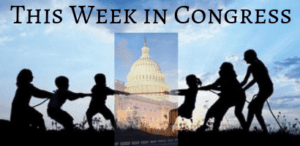The mother of all spending bills was passed on March 27 by the House of Representatives, ending many days of drama and finger-pointing and surviving a last-minute obstacle raised by one GOP representative. The COVID-19 virus has ravaged the U.S. economy to a greater extent than it has the population, thanks to the extreme and unprecedented measures taken across the country by state governments. For months and perhaps even years to come, the biggest question may not be whether too much money was spent but whether the economic shutdown that made the bill necessary was the wisest course of action.
 Passed by voice vote, the $2.2 trillion bill is the most massive single spending bill in American history. While many Democrats objected to provisions that distribute billions to U.S. industry, including airlines that have been hit hard by both restrictions and “social distancing” practices causing many to cancel travel plans, Republicans balked at expenditures on projects not connected to the pandemic.
Passed by voice vote, the $2.2 trillion bill is the most massive single spending bill in American history. While many Democrats objected to provisions that distribute billions to U.S. industry, including airlines that have been hit hard by both restrictions and “social distancing” practices causing many to cancel travel plans, Republicans balked at expenditures on projects not connected to the pandemic.
Epic Spending and Congressional Dysfunction
“The amount of money we’re committing is in itself epic,” said Rep. Andy Biggs (R-AZ), who heads the GOP’s Freedom Caucus. Citing the millions set aside for the John F. Kennedy Center for the Performing Arts and additional amounts that will go to arts and education projects, Biggs added: “These may be worthy or not, but they certainly have no place in an economic relief package.”
Even if one accepts that the measures taken to combat the spread of COVID-19 were entirely necessary, it is impossible to avoid the conclusion that the dysfunction on Capitol Hill was more apparent than ever over the past couple of weeks. Faced with a national crisis, the two parties squabbled over funding for pet projects. Democrats, in particular, attempted to use the legislation as a way to implement their political and economic agenda.
Rational and genuinely concerned lawmakers would have written a clean bill aimed solely at shoring up the economic problems resulting from the fight to contain the Coronavirus.
Deficits and the ever-growing national debt have, at various times, been used by each party as a cudgel with which to beat the other. This gargantuan payout, though, proves once again that both are culpable when it comes to fiscal irresponsibility.
Ultimately, we may all look back and wonder whether it was all worth it or, indeed, justified. Even if COVID-19 claims another 20,000 American lives by the end of April 2020, it would not have proven as deadly as the seasonal flu with which the nation deals every year.
As the November presidential election draws closer, Republicans and Democrats will trade accusations over federal government spending, and their words will ring hollow in the ears of those voters who paid attention to what has transpired over the past two months. Was it worth putting the brakes on a roaring economy and then throwing more than $2 trillion into the furnace to start it up again? Would it not have cost far less to deal with mass infection – ultimately resulting in herd immunity – and continued along the path to prosperity, rather than turning the country on its head?
~
Read more from Graham J. Noble.
For home study students and young people, Liberty Nation recommends…
All About Coronavirus
High School: The Spread of Coronavirus: How it Works
Middle School: A Scientific Look at COVID-19
Elementary School: Coronavirus: The Science
Government Response To Coronavirus
High School: White House Acts on Coronavirus
Middle School: Trump Takes Action on Coronavirus
Elementary School: Trump Versus Coronavirus




